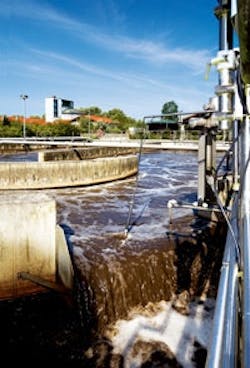About the author: Rob Smith, Ph.D., P.E., BCEE, is applications engineer - wastewater for YSI, a Xylem brand. Smith can be reached at [email protected] or 937.767.7241.
Energy usage at water resource recovery facilities (WRRF) is a big deal. The cost of energy is the single largest operating cost for many and trending higher. The single largest energy consumer for most facilities is the activated sludge aeration system. The most common target for aeration system optimization is dissolved oxygen (DO) concentration. DO is essential to the microorganisms that consume organic pollution and ammonia, but there is a point of diminishing benefit. The reaction rate for nitrification, for example, increases proportional to the DO concentration up to about 1.5 mg/L, but beyond that, the organisms become saturated and the reaction rate does not increase appreciably no matter how high the DO concentration. This is the basis for maintaining a concentration of no more than 2 mg/L as a rule of thumb.
The options for DO control range from simple manual adjustments based on measurements from grab samples to automated adjustment of blowers and valves with online measurements.
Option One: Manual Control
The simplest control method is known as the “Sneakernet.” Operators walk out to the process, take a sample, walk to the lab to make the measurement, and then walk to the control element—a motor or valve—and make an adjustment to meet current requirements. This can be simplified with the use of handheld DO sensors and by tracking conditions over an extended period. Although wastewater conditions are variable, the patterns typically repeat daily, weekly and seasonally. A dedicated operator learns what adjustments are needed and when. Significant energy savings can be achieved with this strategy, although it is necessary to adjust the system conservatively as a contingency to guarantee performance while the process is not tended, such as on weekends, holidays, or when the operator has other duties. Therefore, investment in online monitoring is needed to take the next step toward reducing energy cost.
Option Two: Feedback Control
In feedback control, the system is adjusted based on a measurement of the treated water. The simplest form of feedback control is on-off control. The control system has two states, for example: on or open when DO is less than the setpoint, and off or closed when the DO is above the setpoint. It therefore can be based on simple relays, which are easily retrofitted. Programming dead band or hysteresis helps to smooth control and reduce wear on blowers and valves. Even so, DO always is above or below the setpoint. Achieving smooth control without starting and stopping requires greater sophistication but offers the greatest potential energy savings.
Air supply rate. A “P” or PI controller can be utilized to modulate air supply rate to maintain a steady setpoint concentration. A “P” controller adjusts the air supply rate proportional to the difference between the measurement and the setpoint, or “error,” in control system parlance. The larger the error, the larger the response. Careful tuning of the gain parameter may be all that is needed for stable control using a “P” controller. For more challenging applications, a PI controller also requires tuning a time component—the reset parameter—to adjust supply proportional to the duration of the error. The greatest investment for this type of control system is typically upgrading the air supply system with control elements—for instance, modulating valves, variable frequency drives or more advanced right-sized blowers.
The simple maintenance and long-term stability of optical DO sensors mean that operators and engineers need to provide reliable online measurements as a basis for aeration control. Maintaining a DO concentration of 2 mg/L, however, does not make sense if there is nothing left to remove. The availability of reliable and affordable ammonium ion selective electrode (ISE) enable more efficient control strategies. The basic approach is to reduce the aeration rate to a minimum level when ammonium is low and no further treatment is needed and to increase aeration up to a maximum DO when ammonium is higher to speed up the process. Oxidation reduction potential also measures the extent of treatment and is very useful in batch treatment systems to control the duration of the aeration stage.
Feedback control is sufficient for most applications, but the best performance at the lowest energy cost requires a prediction instead of reacting to a change.
Option Three: Feedforward Control
Feedforward control adjusts the aeration rate based on calculations from a model programmed into the controller. A simple form of feedforward control, proportioning return sludge pumping rates and chemical feed based on the measured wastewater flow rate, is common in many WRRFs. To control the aeration rate also requires measurement of oxygen- demanding substances in the untreated wastewater. The ammonium ISEs already mentioned and immersible spectrometric probes that determine biochemical oxygen demand from optical absorption measurements for dozens of wavelengths make this possible. In practice, a feedforward feedback strategy is advisable because models are not always perfect. Additional sensors to measure the treated water ensure sufficient treatment and limit aeration in case of an overestimate. The model and additional sensors add to the complexity and cost of the control system, but can be justified based on achieving the highest level of treatment in the shortest time and smallest space possible.
Download: Here
